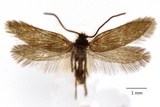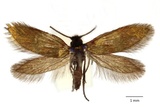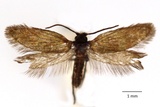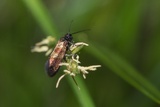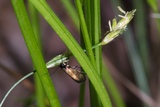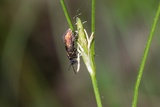Micropterix mansuetella Zeller, 1844 Species
Last modified: Dec. 16, 2025, 6:26 p.m.
This species was observed for the first time in Belgium in 2010 but is still very rare and seldom recorded.
Details
- Classification
- Family: Micropterigidae > Genus: Micropterix > Species: Micropterix mansuetella
- Vernacular names
- Zeggeoermot (NL), Black-headed Gold, Black-headed Pollen-moth (EN), Riedgras-Urfalter (DE)
- First mention in Belgium
- De Prins W. 2016. Catalogus van de Belgische Lepidoptera – Catalogue of the Lepidoptera of Belgium. — Entomobrochure 9: 1–279. On page 20 (as Micropterix mansuetella Zeller, 1844). view page
- Status
-
Native
Distribution
Imago
This moth, having a wingspan of 8–11 mm, wears purplish markings on the wings. It is similar to M. tunbergella but is less clearly marked and is easily distinguished by its black head.
Caterpillar
The larva is still unknown.
Bionomics
The life cycle and caterpillar are still unknown. The imago is day-active and can be found feeding on the pollen of of a wide range of flowers but especially on Carex spp.
Flight periods
The adults fly from early May till mid-June.
Observed on
The hostplant is still unknown.
Habitat
This species is an inhabitant of wet freshwater woodlands, litter meadows, fens, sparse birch, and alder moor forests.
